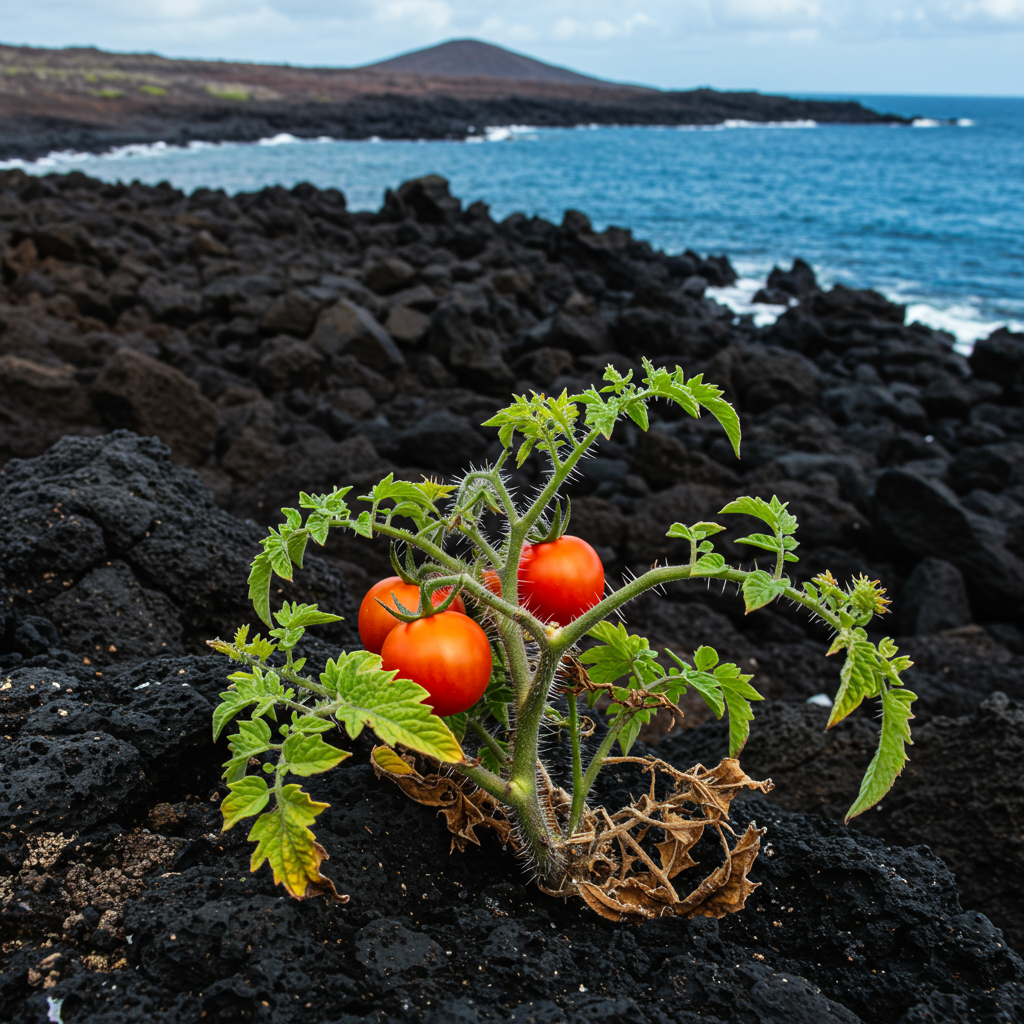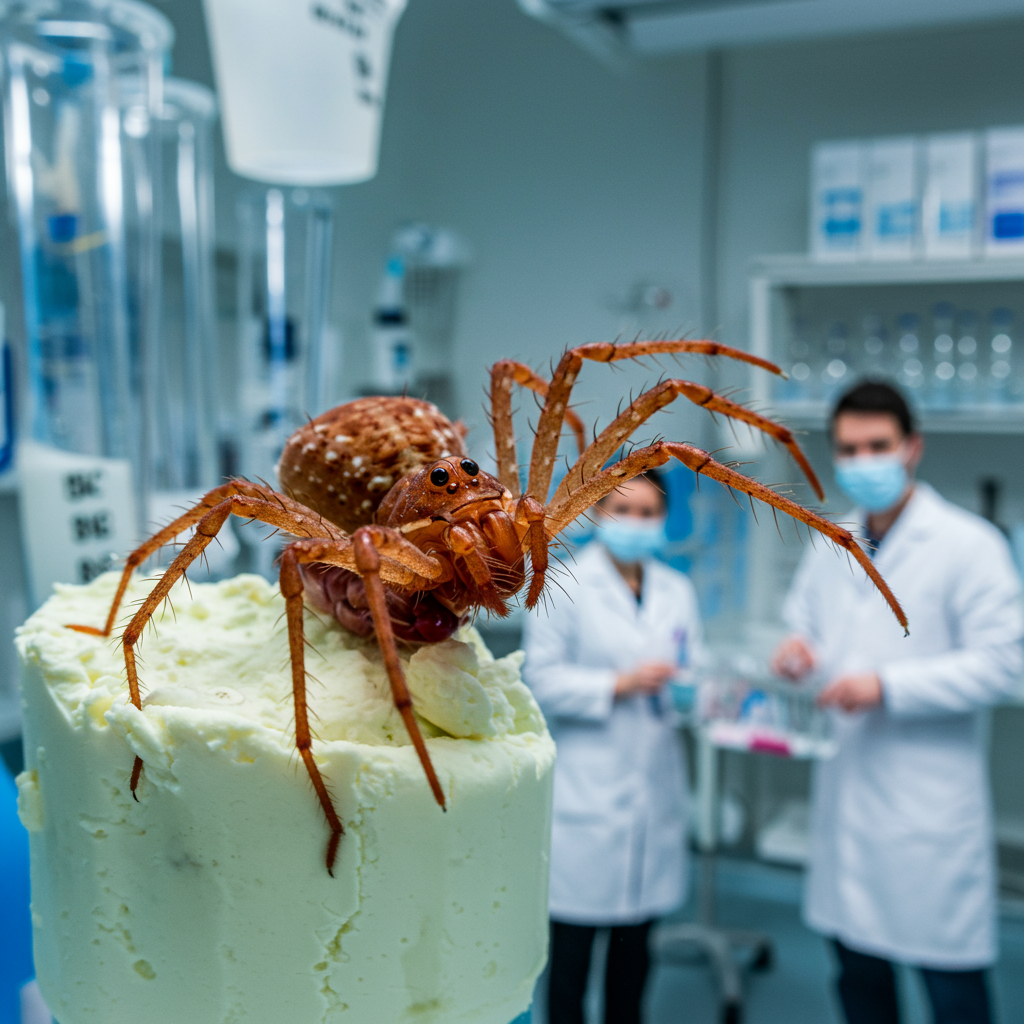On the rugged volcanic coastlines of the Galápagos Islands, something extraordinary is happening in wild tomato plants. These plants are exhibiting what scientists are calling a rare case of “reverse evolution.” Instead of continuously developing newer traits, they are reverting to ancient chemistry. This unexpected step backward holds significant implications for how we understand plant defenses, bitterness, toxicity, and critically, the future resilience of our food crops like tomatoes.
Scientists studying Solanum cheesmaniae, a wild tomato species native to the archipelago, discovered this phenomenon. On the geologically younger, western islands formed by recent volcanic activity, these wild tomatoes possess a molecular makeup remarkably similar to that of their ancestors from millions of years ago. This isn’t just a scientific curiosity. According to Adam Jozwiak, a molecular biochemistry assistant professor at the University of California-Riverside, this chemical throwback could offer a blueprint. It might show us how to strengthen tomato defenses against mounting pest pressures and the increasing need to reduce pesticide use globally.
Ancient Defenses and Modern Trade-offs
Tomatoes, along with other familiar crops in the nightshade family (Solanaceae) like potatoes and eggplants, naturally produce compounds called steroidal glycoalkaloids (SGAs). These chemicals have a bitter taste and can be toxic to insects, fungi, and pathogens. They are a plant’s built-in security system. However, over many decades, traditional plant breeders have intentionally lowered the levels of these SGAs, especially in ripe tomato fruit. The goal was simple: create sweeter, milder tomatoes that consumers prefer.
This focus on flavor had an unintended consequence. Professor Jozwiak points out that by reducing these bitter compounds for palatability, we may have inadvertently weakened the tomato plant’s natural “immune system.” Modern cultivated tomatoes, delicious as they are, often lack the robust, inherent defenses of their wild relatives.
A Chemical Blast from the Past
The wild Galápagos tomatoes offer a startling contrast. Specifically on younger islands like Fernandina and Isabela, S. cheesmaniae plants produce SGAs with a stereochemistry – the 3D arrangement of atoms – that hasn’t been seen in cultivated tomatoes for evolutionary eons. These specific compounds chemically resemble the bitter, bioactive substances found in eggplants and appear to be synthesized through a subtly altered version of a key enzyme called GAME8.
What makes this discovery particularly exciting is the simplicity of the genetic change involved. Researchers found that flipping the chemical signature from the modern form back to this ancient, ancestral one requires remarkably few alterations. It takes just four specific amino acid substitutions within the GAME8 enzyme to make this significant chemical switch.
Unlocking “Designer Plant Chemistry”
This finding is profound because it demonstrates that major plant biochemical pathways aren’t always fixed or irreversibly changed by evolution. In rare instances, they can revert through relatively minor genetic tweaks. To prove this concept, Jozwiak’s team took the modified GAME8 gene from the Galápagos tomatoes and introduced it into tobacco plants. The result? The tobacco plants then began producing the same ancestral alkaloids. This was a clear, predictable demonstration that reversing a major plant chemistry pathway is both possible and controllable.
This level of precision and control over plant biochemistry opens the door to exciting possibilities. Professor Jozwiak refers to this potential as “designer plant chemistry.” Instead of simply breeding for low bitterness, breeders and biotech companies could potentially tailor the alkaloid profiles of crops. The aim would be to strike a complex balance between enhancing pest resistance, ensuring food safety, maintaining desirable flavor, and potentially even impacting shelf life.
Strategic Defense Approaches
Implementing “designer plant chemistry” requires strategic thinking. If the primary goal is boosting pest resistance, a logical approach could involve upregulating specific biosynthetic enzymes critical for SGA production, particularly GAME8, GAME6, and GAME15. However, this wouldn’t be a blanket increase throughout the plant.
Targeting specific plant tissues or developmental stages is key. Boosting SGAs primarily in parts not typically eaten by humans, such as leaves and stems, could significantly increase deterrence against pests without negatively impacting the quality or taste of the fruit. Another strategy could involve carefully managing the timing of chemical conversions during the fruit’s development. For example, delaying the natural transformation of α-tomatine (a bitter, toxic SGA) into its non-toxic counterpart, esculeoside A, could provide crucial protection when the fruit is young and vulnerable, while still ensuring the fruit is palatable and safe by the time it ripens for harvest. Analytical chemistry techniques like LC-MS (Liquid Chromatography-Mass Spectrometry) or HPLC (High-Pressure Liquid Chromatography) are essential tools for precisely screening and monitoring these complex chemical profiles throughout the process.
Navigating Safety and Stability
While the prospect of enhancing natural plant defenses is promising, it must be approached with caution. Steroidal glycoalkaloids, while natural, can be toxic to both humans and animals if consumed in high amounts. Modern tomatoes typically have SGAs in unripe fruit and vegetative parts, with very low concentrations, if any, in ripe fruit.
Any commercial application involving increased SGA levels would require meticulous scientific evaluation and stringent regulatory scrutiny. Professor Jozwiak emphasizes that a careful, science-based approach is essential. If the manipulation impacts the edible parts of the plant, rigorous safety assessments would be paramount before any widespread use.
Beyond safety, there are ecological considerations. The “reverse evolution” trait in the Galápagos tomatoes appears stable across different populations on the islands. Researchers hypothesize this stability is driven by strong local selective pressures, possibly from herbivores, microbes, or unique climate conditions. Whether this trait would remain stable and effective in the vastly different environments of commercial agriculture is uncertain. The expression and persistence of these alkaloids could be influenced by numerous factors, including the surrounding ecosystem, the specific pests present, soil microbes, and overall climate conditions.
Gene flow also presents a challenge. In major tomato growing regions, where many different varieties are cultivated near each other, pollination could potentially spread or dilute this engineered trait in subsequent generations. Strict breeding controls would likely be needed to maintain the desired chemical profile.
Broader Potential and Future Direction
The implications of this discovery extend beyond just tomatoes. Other crucial nightshade crops, such as potatoes and eggplants, also rely on steroidal glycoalkaloids for defense. Importantly, they utilize enzymes from the same family, including GAME8-like proteins, to build these defense compounds. Understanding how to manipulate SGA biosynthesis in tomatoes could directly translate to developing more pest-resistant or disease-tolerant varieties of these other staple crops. However, as with tomatoes, efforts to reduce alkaloid content for flavor or safety in these crops have also often come with the trade-off of reduced defense capacity. Striking the right balance between taste, safety, and resilience remains a central challenge.
Achieving this delicate balance could be facilitated by advanced breeding techniques. Gene editing technologies, like CRISPR, could be used to introduce specific mutations that precisely shift chemical profiles, targeting those four key amino acid changes in GAME8, for instance. Marker-assisted breeding, using the enzyme structure or related genetic markers as guides, also offers a pathway to select for desired alkaloid traits.
Ultimately, this research suggests a pivot in our approach to tomato breeding and potentially the breeding of other crops. Instead of viewing bitterness solely as a flaw to be eliminated, we could explore its strategic reintroduction or modulation as a powerful tool. This could pave the way for a more sophisticated, defense-aware approach to agriculture. As researchers continue to unravel the precise interactions of SGA stereochemistry with insect deterrence, microbial interactions, and even taste receptors, the path towards building more resilient crops for the future may surprisingly involve learning from the evolutionary past.
Frequently Asked Questions
What are steroidal glycoalkaloids (SGAs) and why are they important in plants like tomatoes?
Steroidal glycoalkaloids (SGAs) are naturally occurring bitter-tasting, potentially toxic compounds found in plants of the Solanaceae family, including tomatoes, potatoes, and eggplants. They serve as the plant’s primary natural defense system, protecting them from pests like insects, fungi, and pathogens. These compounds are crucial for the plant’s survival in the wild, though their levels have been reduced in cultivated crops for flavor and safety.
How does “reverse evolution” in Galápagos tomatoes relate to potential future crop breeding?
The discovery of Galápagos wild tomatoes reverting to an ancestral chemical profile (SGAs with ancient stereochemistry) via a simple genetic change (4 amino acids in GAME8 enzyme) demonstrates that powerful defense traits lost during domestication can potentially be reawakened. This insight offers a blueprint for “designer plant chemistry,” suggesting breeders could use techniques like gene editing to precisely reintroduce or modulate these ancient defenses in modern crops, enhancing resilience without heavy reliance on pesticides.
What are the potential benefits and risks of manipulating tomato plant chemistry for defense?
Potential benefits include creating crops with enhanced natural pest resistance, which could lead to reduced reliance on synthetic pesticides, lower farming input costs, and improved environmental health (benefiting pollinators and soil). The main risk involves the toxicity of SGAs to humans and animals at high concentrations. Any manipulation, especially affecting edible parts, would require rigorous safety testing, precise control (e.g., tissue-specific expression), and strict regulatory approval to ensure public safety.
Conclusion
The remarkable discovery in Galápagos tomatoes challenges conventional evolutionary thinking and presents a compelling opportunity for agriculture. By understanding how wild plants can re-engage ancient chemical defenses through surprisingly simple genetic changes, scientists are opening new doors. This research points towards a future where we can potentially breed crops with enhanced natural resilience, leveraging their inherent biological tools rather than solely relying on external chemical inputs. Balancing defense, flavor, and safety through precise genetic and biochemical manipulation represents a complex yet vital challenge for creating sustainable food systems for generations to come.




